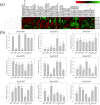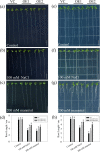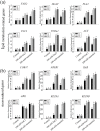Molecular characterization, expression and functional analysis of acyl-CoA-binding protein gene family in maize (Zea mays)
- PMID: 33588749
- PMCID: PMC7883581
- DOI: 10.1186/s12870-021-02863-4
Molecular characterization, expression and functional analysis of acyl-CoA-binding protein gene family in maize (Zea mays)
Abstract
Background: Acyl-CoA-binding proteins (ACBPs) possess a conserved acyl-CoA-binding (ACB) domain that facilitates binding to acyl-CoA esters and trafficking in eukaryotic cells. Although the various functions of ACBP have been characterized in several plant species, their structure, molecular evolution, expression profile, and function have not been fully elucidated in Zea mays L.
Results: Genome-wide analysis identified nine ZmACBP genes in Z. mays, which could be divided into four distinct classes (class I, class II, class III, and class IV) via construction of a phylogenetic tree that included 48 ACBP genes from six different plant species. Transient expression of a ZmACBP-GFP fusion protein in tobacco (Nicotiana tabacum) epidermal cells revealed that ZmACBPs localized to multiple different locations. Analyses of expression profiles revealed that ZmACBPs exhibited temporal and spatial expression changes during abiotic and biotic stresses. Eight of the nine ZmACBP genes were also found to have significant association with agronomic traits in a panel of 500 maize inbred lines. The heterologous constitutive expression of ZmACBP1 and ZmACBP3 in Arabidopsis enhanced the resistance of these plants to salinity and drought stress, possibly through alterations in the level of lipid metabolic and stress-responsive genes.
Conclusion: The ACBP gene family was highly conserved across different plant species. ZmACBP genes had clear tissue and organ expression specificity and were responsive to both biotic and abiotic stresses, suggesting their roles in plant growth and stress resistance.
Keywords: Acyl-CoA binding protein (ACBP); Evolution; Expression profiles; Stress; Subcellular localization; Zea mays.
Conflict of interest statement
The authors declare that they have no conflict of interest.
Figures









Similar articles
-
The rice acyl-CoA-binding protein gene family: phylogeny, expression and functional analysis.New Phytol. 2011 Mar;189(4):1170-1184. doi: 10.1111/j.1469-8137.2010.03546.x. Epub 2010 Dec 3. New Phytol. 2011. PMID: 21128943
-
Phylogeny and subcellular localization analyses reveal distinctions in monocot and eudicot class IV acyl-CoA-binding proteins.Planta. 2021 Sep 10;254(4):71. doi: 10.1007/s00425-021-03721-1. Planta. 2021. PMID: 34505938
-
Over-expression of Medicago Acyl-CoA-binding 2 genes enhance salt and drought tolerance in Arabidopsis.Int J Biol Macromol. 2024 May;268(Pt 1):131631. doi: 10.1016/j.ijbiomac.2024.131631. Epub 2024 Apr 16. Int J Biol Macromol. 2024. PMID: 38631584
-
Plant acyl-CoA-binding proteins: An emerging family involved in plant development and stress responses.Prog Lipid Res. 2016 Jul;63:165-81. doi: 10.1016/j.plipres.2016.06.002. Epub 2016 Jun 29. Prog Lipid Res. 2016. PMID: 27368137 Review.
-
An Arabidopsis family of six acyl-CoA-binding proteins has three cytosolic members.Plant Physiol Biochem. 2009 Jun;47(6):479-84. doi: 10.1016/j.plaphy.2008.12.002. Epub 2008 Dec 16. Plant Physiol Biochem. 2009. PMID: 19121948 Review.
Cited by
-
Identification of Genetic Variations and Candidate Genes Responsible for Stalk Sugar Content and Agronomic Traits in Fresh Corn via GWAS across Multiple Environments.Int J Mol Sci. 2022 Nov 4;23(21):13490. doi: 10.3390/ijms232113490. Int J Mol Sci. 2022. PMID: 36362278 Free PMC article.
-
Genome-wide identification of acyl-CoA binding proteins and possible functional prediction in legumes.Front Genet. 2023 Jan 10;13:1057160. doi: 10.3389/fgene.2022.1057160. eCollection 2022. Front Genet. 2023. PMID: 36704331 Free PMC article.
-
Acyl-CoA-binding protein (ACBP) genes involvement in response to abiotic stress and exogenous hormone application in barley (Hordeum vulgare L.).BMC Plant Biol. 2024 Apr 2;24(1):236. doi: 10.1186/s12870-024-04944-6. BMC Plant Biol. 2024. PMID: 38561660 Free PMC article.
-
A Comprehensive Analysis In Silico of KCS Genes in Maize Revealed Their Potential Role in Response to Abiotic Stress.Plants (Basel). 2024 Dec 16;13(24):3507. doi: 10.3390/plants13243507. Plants (Basel). 2024. PMID: 39771204 Free PMC article.
-
Plant Acyl-CoA-Binding Proteins-Their Lipid and Protein Interactors in Abiotic and Biotic Stresses.Cells. 2021 Apr 30;10(5):1064. doi: 10.3390/cells10051064. Cells. 2021. PMID: 33946260 Free PMC article. Review.
References
-
- Xie LJ, Yu LJ, Chen QF, Wang FZ, Huang L, Xia FN, Zhu TR, Wu JX, Yin J, Liao B, Yao N, Shu W, Xiao S. Arabidopsis acyl-CoA-binding protein ACBP3 participates in plant response to hypoxia by modulating very-long-chain fatty acid metabolism. Plant J. 2015;81:53–67. doi: 10.1111/tpj.12692. - DOI - PMC - PubMed
MeSH terms
Substances
Grants and funding
LinkOut - more resources
Full Text Sources
Other Literature Sources

